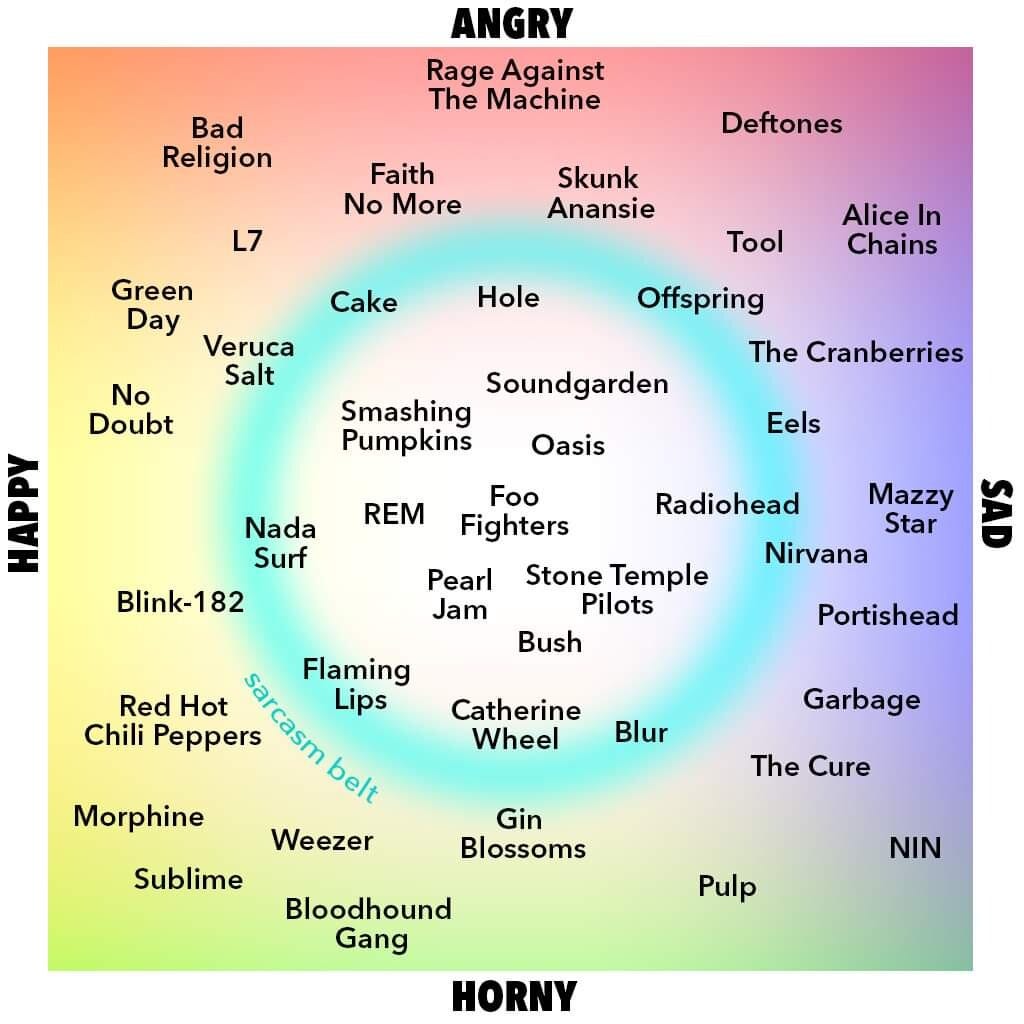🦈✨The Nexialist #0142
90s bands alignment chart | world built on pain | designed to depress | dangerous beauty | blockbuster template
welcome to another week of cyber-wandering, the nexialist
hey, you! i hope this message finds you safe and well! these past few days have not been the best. not only the weather change and shorter days, but also the political climate and horrible news from palestine and israel. i don’t have the repertoire/energy to comment on this, so today i brought content to bring you brainsparks from other areas: music, pleasure (and pain), design, beauty and blockbusters. it’s a shorter edition, so savour it and don’t rush. 🫀✨
1 year ago » 🪦✨The Nexialist #0090 : third places | heterotopia | plaskrul | legacy of gifs | wuthering heights | la emperatriz | grapefruit | la isla de lesbos | brazil elects two trans women
2 years ago » 😏✨The Nexialist #0041 : Some Updates | Atheist | A Second to Midnight | Full of Yourself | Soledad | Debilidad | Exaggerated | Cool
🎸90s bands alignment chart
lemme tell you, my flaneuring through the big think’s strange maps session a few weeks ago gave me so much material. this chart is just next level, with the more internal moods of happy x sad, and a more “customer-facing” axis of angry and horny. the “sarcasm belt” is just the cherry on the cake and makes me want to organize my musical taste in this chart. the chart was created by lana (or @dragonfly), and she even made an 80s band alignment chart (and the belt in the middle is over something different.)
brainspark: sad&horny (tn#26), emotional plurality (tn#15)
💥world built on pain
’s post on brings pleasure activism, which we love here at the nexialist, neatly tied together with other concepts and content, starting with this punchline above. it’s such a powerful realization and it hits close to home: many times, i tend to think about what will go wrong, even in moments that are supposed to be relaxing (like my vacations or other trips). for me, it is another reminder to also think of the pleasure points, not only in this micro-level, but in other things we do.The organizing principle of the modern world is pain.
To build a world that is truly sustainable and just, pleasure needs to replace pain and become the new organizing principle of our future.
A very practical translation of this is the following:
To ‘sell’ a sustainable future to the people, we need to show them the pleasure that comes with that future rather than the pain that comes with it. From solving pain points to solving pleasure points.
brainsparks: pleasure activism, age of pleasure (tn#123), an economy of suffering, rituals of suffering (tn#59), a measure of sacrifice (tn#40)
🐑designed to depress
this week, the nexialist was featured
’s borrowed perspectives (thank you ), with some great additional brainsparks of her own alongside other great creators. How to Be Happy In a World Designed to Depress You jumped at me and felt like a slap: pairing design and depression was not something my brain had put together before, as design is usually linked to improving people’s lives, but it is so true. mentions a passage from Matt Haig’s memoir Reasons to Stay Alive, which i was not familiar with:"The world is increasingly designed to depress us. Happiness isn’t very good for the economy. If we were happy with what we had, why would we need more?
"How do you sell an anti-aging moisturizer? You make someone worry about aging. How do you get people to vote for a political party? You make them worry about immigration. How do you get them to buy insurance? By making them worry about everything. How do you get them to have plastic surgery? By highlighting their physical flaws. How do you get them to watch a TV show? By making them worry about missing out. How do you get them to buy a new smartphone? By making them feel like they are being left behind.
"To be calm becomes a kind of revolutionary act. To be happy with your own non-upgraded existence. To be comfortable with our messy, human selves, would not be good for business."
she proceeds to tell us the story of her grandmother’s friend, Ivan, who, in his simplicity, reminded her of the pleasure in the mundane. it reminded me of caroline caldwell’s quote
“In a society that profits from your self doubt, liking yourself is a rebellious act.” — Caroline Caldwell
brainsparks: nakedness (tn#13), the art of living outside of conventions (tn#75)
🖼️dangerous beauty
thank you
for sharing this ’s text: The Most Dangerous Thing in Culture Right Now is Beauty. Gioia explains how, despite people devoting half of their waking hours to the consumption of culture, cultural institutions are in collapse and a de-institutionalization of arts and entertainment is underway. it’s quite a powerful statement, i know. but could it also serve as some kind of blueprint for other highly institutionalized/mega-industrialized industries?But right now I want to tell you what beauty is NOT. It doesn’t require validation by an institution. It can’t be manipulated by a corporation. It doesn’t need or want theory or interpretation. It’s not mediated through a critic.
Now you can begin to understand why beauty is dangerous. It’s the closest thing to anarchy and liberation in our public lives.
In other words, the future of aesthetics looks more like Tumblr than MOMA.
his text ends on a positive note, as “a whole culture ecosystem flourished outside these behemoth enterprises… locales where individuals experienced direct relationships of desire, pleasure, and intimacy with cultural objects of every persuasion. These were the places where beauty could be found, without corporate gatekeepers or institutional domination. They have been mostly squeezed out of existence by large tech companies. But the desires they fulfilled are unsatiated by the ever present tentacles of Disney, Google, Amazon, etc. The prison rebellion is already underway. A refusenik indie culture is returning, although it may look different from the bohemian micro-cultures of the past….”
brainsparks: kulturindustrie (tn#125)
🦈blockbuster template
summer take-over blockbusters don’t happen by accident. they require intricate (and expensive) hype strategies that start long before we think. they are inflated to become more than just a movie launch, but an event that you cannot miss. i loved this case study, especially when they explain how the usual blockbuster follows certain “cash grab” aesthetics, but barbie, like jaws, had a more elevated and artsy elements than expected (yes, still ultraprocessed, but as greta gerwig said: authentic artificiality (tn#130).
how jaws created the modern blockbuster template:
part 1: leveraging pre-existing intellectual property
part 2: overwhelming market saturation
part 3: wide release
brainsparks: barbie’s authentic artificiality (tn#130), the beach party genre (tn#98)
see you next week, sharks 🦈✨
❓If you want to know what a Nexialist is, click here.
🔎If you want to see what I’ve already posted, visit the archive and use the search engine. Even I do that a lot.
💌I want to know what you think/who you are! Your feedback is highly appreciated; you can e-mail me or fill in this short survey. Thank you! 🙏🏻
🔌Let’s Collab?
I truly believe innovation comes from bringing improbable areas together, and that’s why I called this project The Nexialist. Some sectors are known to be self-referencing and hermetic. Sometimes teams are on autopilot mode, focused on the daily grind, which hinders innovation. As a Nexialist, I like to burst these bubbles, bringing references from different areas, and maintaining teams inspired and connected to the Zeitgeist.
I offer inspiration sessions called Brainsparks, creative desk research (Zeitgeist Boost), Plug’n’Play deals for workshops and sprints, and other bespoke formats. If you want to know more about this, send me an e-mail with your challenge(s) and we can figure something out together. Check out my website and some work I’ve done below:






